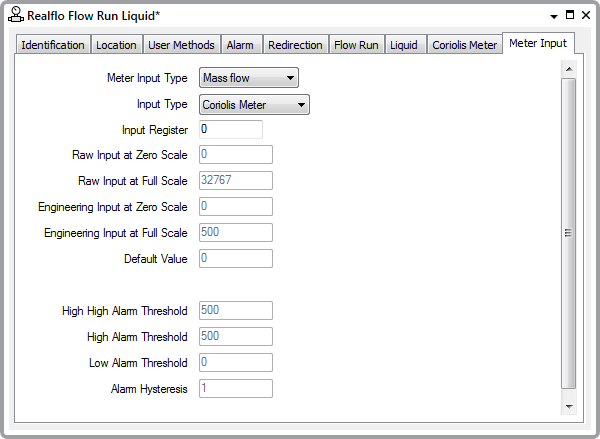The fields on the Meter Input tab vary depending on the Meter Input Type that you selected. This topic describes the fields related to either the Mass flow or Volume flow Meter Input Type. (The latter type of meter input only applies to Liquid and Water Flow Runs.)
You can configure these properties directly in ClearSCADA, or read the configuration into the ClearSCADA database (see Configure or Read the Flow Run Configuration).

- Input Type—if you select a Mass or Volume flow Meter Input Type you can select from one of the following input types:
- Telepace Integer
- Float
- Raw Float
- ISaGRAF integer
- Coriolis Meter
- Input Register—With an Input Type other than 'Coriolis Meter', use this field to define the address of the register that contains the input value. Valid values are in the ranges 30001 to 39998 and 40001 to 49998.
When using Realflo 6.95 or above, if the Input Type is set to 'Coriolis Meter', use this field to specify which Coriolis Meter is to provide the input value. Enter a value in the range 1 to 10 inclusive, where the number corresponds to the number of the Flow Run on which the Coriolis meter is configured (and, as such, the Flow Run that will poll that particular Coriolis meter). For example, enter 2 to use the Coriolis meter that is configured on Flow Run 2.
- Raw Input at Zero Scale—Specify the value read from the sensor when the sensor is at zero scale.
Valid values depend on the input type. The default value is 0.
This field is available for options other than the Float or Coriolis Meter
- Raw Input at Full Scale—Specify the value read from the sensor units when the sensor is at full scale.
Valid values depend on the input type. The default value is 32767.
This field is available for options other than the Float or Coriolis Meter
- Engineering Input at Zero Scale—Specify the value that corresponds to the zero scale input. Valid values depend on the input type.
This field is available for options other than the Coriolis Meter.
- Engineering Input at Full Scale—Specify the value that corresponds to the full-scale input. Valid values depend on the input type.
This field is available for options other than the Coriolis Meter.
- Default Value—This is enabled when the Input Type is set to Coriolis Meter and allows you to set the value for the input variable to use when the Sensor Fail Values option in the Input Properties section of the Flow Run tab is configured to Use Configured Defaults.
The availability of the fields in this section varies, depending on the Input Type.
The input alarms fields allow you to set the alarm thresholds for alarm types that have been enabled in the Input Properties section.
Use the following to configure alarm limits:
- High-High Alarm Threshold—Set the high-high alarm threshold value for the mass/volume flow. A valid entry value is any value within the mass/volume flow range that is higher than or equal to the value of the High Alarm Threshold. The default value is 500. This control is enabled if High-High Alarm option is enabled on the Input Properties section, otherwise this control is unavailable.
- High Alarm Threshold—This allows you to set a high alarm threshold for the mass/volume flow. A valid entry value is any value within the mass/volume flow range that is higher than the value of Low Alarm Threshold, and is lower than or equal to the value of High-High Alarm Threshold. The default value is 500. This control is enabled if High Alarm option is enabled on the Input Properties section, otherwise the control is unavailable.
- Low Alarm Threshold—This allows you to set a low alarm threshold for the mass/volume flow value. A valid entry is any value in the mass/volume flow range that is lower than the value of the High Alarm Threshold. The default value is 0. This control is enabled if the Low Alarm option is enabled on the Input Properties section, otherwise the control is unavailable.
- Alarm Hysteresis—Set the hysteresis value for each configured alarm type. The hysteresis setting determines at what level alarms are cleared when the input variable reading returns to a non-alarm state. This setting reduces nuisance alarms around the alarm threshold. Enter a value in the full-scale range of the input variable.
Further Information
For more detailed information on these properties, see the documentation provided with the Realflo application.